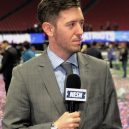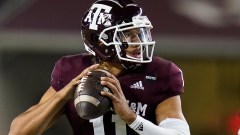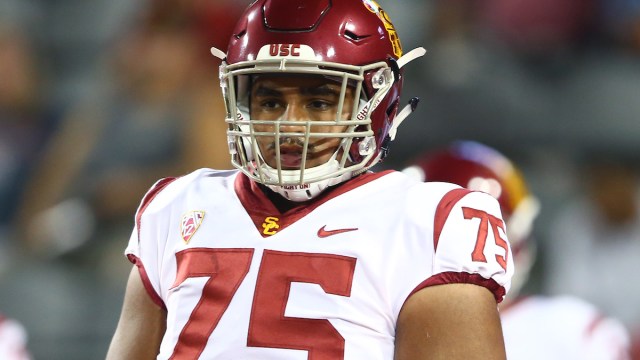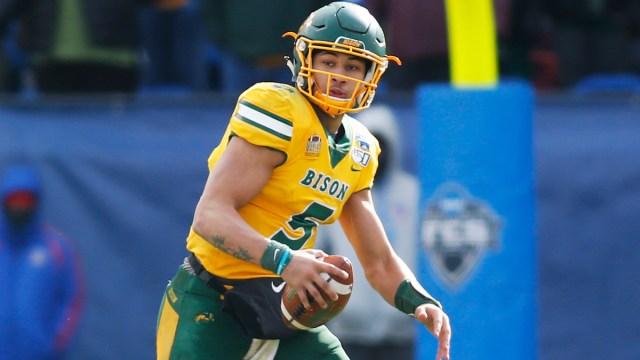In the weeks leading up to the 2021 NFL Draft, NESN.com will be taking a closer look at this year’s quarterback class and how each player could fit with the New England Patriots. Next up: Ohio State’s Justin Fields.
Justin Fields, Ohio State
6-foot-2 3/4, 227 pounds, 9 1/8-inch hands
Projected round: Early first
2020 stats: 70.2 percent (158-for-225), 2,100 yards, 22 touchdowns, six interceptions, 10.1 yards per attempt; 63 carries, 517 yards, five touchdowns (eight games; rest of season canceled due to COVID-19)
2019 stats: 67.2 percent (238-for-354), 3,273 yards, 41 touchdowns, three interceptions, 11.2 yards per attempt; 114 carries, 688 yards, 10 touchdowns (14 games)
Strengths: Accuracy, intelligence, mobility, ball security, arm strength
Weaknesses: Sometimes needs to live to see another day rather than taking a sack or throwing an interception
Testing numbers: 4.46-second 40-yard dash, 1.59-second 10-yard split (no other testing — choice)
Analysis: Fields was considered the second-best quarterback prospect in the 2021 class heading into the last college football season, and now he might be the fourth or even fifth QB off the board behind Clemson’s Trevor Lawrence, BYU’s Zach Wilson, Alabama’s Mac Jones and North Dakota State’s Trey Lance.
Lawrence is a lock to be selected first overall by the Jacksonville Jaguars and the New York Jets are expected to take Wilson second. The San Francisco 49ers traded up to No. 3 overall and will not take Fields, according to former NFL exec Michael Lombardi, who projects them to select Jones or Lance.
The 49ers’ preference befuddled a league source we spoke with Sunday who wondered why San Francisco would trade up for any quarterback other than Fields.
If San Francisco doesn’t take Jones or Lance, it’s good news for the Patriots who currently sit at No. 15 overall and have the draft capital to move up for a QB. To add Fields, New England probably would have to trade up to No. 7 (Detroit Lions) or No. 8 overall (Carolina Panthers). The Patriots could also trade up with the Atlanta Falcons at No. 4 or the Cincinnati Bengals at No. 5 overall, though it would take a heftier haul. It’s unlikely the Miami Dolphins, an AFC East rival, would be willing to part with their No. 6 overall pick nor deal it to the Patriots.
So, what is there to like about Fields? Almost everything.
He’s incredibly accurate to all areas of the field (he even completed nearly 60 percent of his deep passes), zips the ball with ease to all levels, limits mistakes and turnovers, maneuvers the pocket well, has the speed to make big plays with his legs, can throw on the move and is highly intelligent.
Fields was recruited by Harvard, Yale, Duke and Northwestern, among other top academic schools. He also scored in the top 1 percent out of 6,500 athletes on a mental aptitude test, according to former NFL QB Mark Sanchez.
The Ohio State product is one of the smartest and most efficient quarterbacks in the 2021 NFL Draft who also just happens to run a 4.46-second 40-yard dash. His mobility essentially is an added bonus in an era when athleticism is becoming more and more important among NFL signal-callers. Fields doesn’t have the vision or scrambling ability of a quarterback like Lamar Jackson as a runner, but he also doesn’t need to because he’s so good as a passer, and he’s still a big-play threat on the move because of his combination of size and speed.
Fields’ biggest issue essentially boils down to the fact that there are times when he should be throwing the ball away but instead he’s pushing his luck to make something happen. He ate too many sacks at Ohio State and many of his interceptions were ill-advised decisions rather than inaccurate passes when he held the ball for too long. These ultimately are nitpicks that can easily be fixed with an otherwise exceptional quarterback prospect.
Among 155 college quarterbacks charted by PFF last season, Fields ranked second in adjusted completion percentage behind Jones, 24th (second among legitimate draft prospects) in average depth of target and fourth (second among legitimate draft prospects) in air yard percentage. We calculated turnover-worthy plays (a PFF metric) per drop back, and Fields ranked 26th (fifth among legit draft prospects) in that rate.
Finally, we combined adjusted completion percentage, average depth of target and turnover-worthy play rate into one metric and accuracy and depth into another. Fields ranked second among draft prospects behind Wilson, who played against a much lower level of competition, in both.
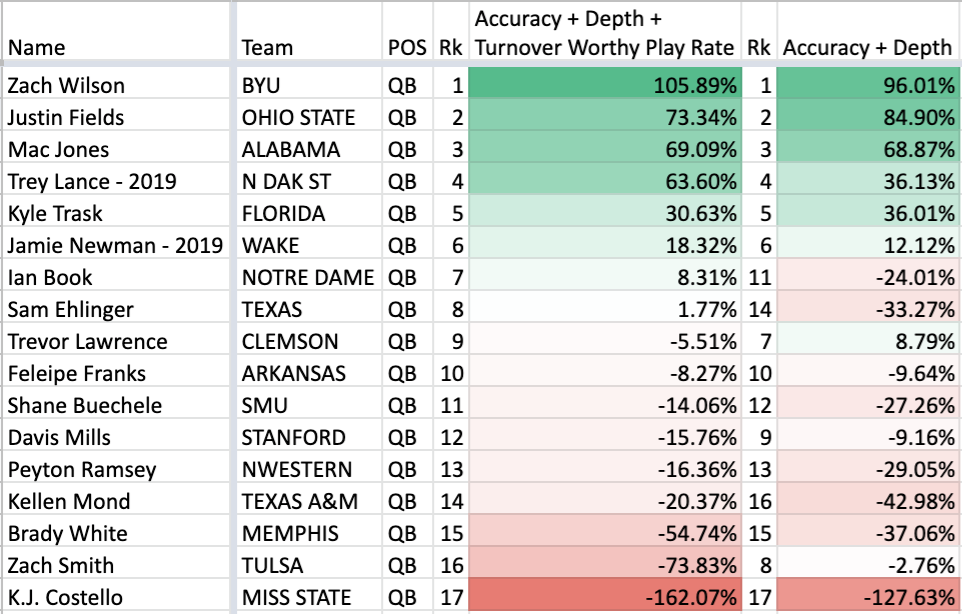
Wilson and BYU didn’t face a single Power 5 conference school in 2020. They played just two ranked schools (Boise State and Coastal Carolina) and split those matchups. Fields, meanwhile, faced five ranked colleges including Clemson (No. 2 at the time) and Alabama (the national champions). Fields was surrounded by top-tier talent, but only 30.1 percent of his passing yards came after the catch. Yards after catch accounted for 37.7 percent of Wilson’s passing yardage.
Lawrence has been the top quarterback prospect since he stepped onto the field at Clemson. It’s understandable that Fields didn’t pass him in two impressive seasons at Ohio State (he transferred from Georgia before the 2019 season after Adam Sasser, a Bulldogs baseball player who ultimately was dismissed from the program, directed racist comments at the quarterback in the stands during a football game).
It’s odd that Wilson, and perhaps Jones, were able to leapfrog Fields in 2020. Fields is more mobile and just as accurate as Wilson. He’s more mobile and had a much higher average depth of target but was slightly less accurate than Jones. Jones was helped out significantly by the talent around him. Alabama receiver DeVonta Smith won the Heisman Trophy, and he and fellow Crimson Tide wideout Jaylen Waddle both are expected to be Top 15 picks. Of Jones’ 4,500 yards, 52.2 percent came after the catch, and 13.1 percent came on screen passes. Meanwhile, only 4.1 percent of Fields’ passing yards came on screens.
Ultimately, the Patriots are probably more likely to stand pat at No. 15 or move up only a few spots in the first round of the 2021 NFL Draft than they are to trade up for a quarterback. But they just filled all of their major needs in free agency. Adding a quarterback as talented as Fields on a rookie contract makes a ton of sense. The question becomes whether he falls and if the Patriots are willing to pull the trigger.
It’s rare for a quarterback of Fields’ character, intelligence, accuracy and mobility to potentially be available outside the top five picks in the draft. If the 49ers take Jones or Lance, then Fields could be the top value in the draft.
More QB prospect profiles: Trey Lance, Zach Wilson
